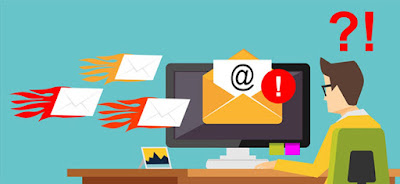WHAT IS EMAIL BOMBARDMENT?


When we were children, many of us learned from our families or teachers not to talk to strangers. Yet somehow, in the virtual world of the Internet, people seem to have forgotten this essential security lesson and willingly participate in information exchanges via email with "strangers." This puts your customers, your data, and your organization in general at risk.

So how can you help your
business avoid being the next victim of a data breach due to phishing, malware,
and other predatory tactics? Following the security practices for the use of
your email.
1. Create a
comprehensive cyber security plan that has email
Having a developed and
comprehensive cyber security plan can help your business avoid or be prepared
to face many of the threats lurking online. No matter how big or small your
organization is, if you don't have a cybersecurity plan yet, you should get one
now.
Your cybersecurity
strategy should include guidelines, policies, recommendations, and requirements
regarding the implementation and use of technology. This includes email
communications.
2. Regularly conduct
cyber awareness training for your employees
Cybersecurity awareness
training is vital for every employee at every level in every organization. It
doesn't matter if you are a multi-national company or a small family business,
whether you work as a CEO, a middle manager or a personal assistant, you are
still a potential target for cybercriminals. This means that you must be able
to react appropriately to email-based threats.
When one of your
employees receives a phishing email with some kind of attachment, there are two
main ways to respond:
The end user interacts
with the attachment, allowing their computer or device to become infected with
malware, which can lead to a breach of your network or even a ransomware
attack.
They choose to mark the
email as junk or spam, perhaps even taking a moment to send an email to your
company's IT team to let them know what just happened.
As the example above
shows, effective computer security training can help your employees learn to
safely identify and handle spam and phishing emails. This includes training them
to properly flag spam and other malicious emails. However, it is essential to
emphasize that this training is not a one-size-fits-all solution. It is
something that has to happen continually because email scam tactics have
evolved. In fact, some phishing emails are so compelling that they can fool
even seasoned IT security experts.
The decision to
implement the training is up to you: some companies prefer to offer
self-training materials online or in print, others prefer face-to-face or an
integration of the two methods. Do what works best for your company and your
employees. Just be sure to continue to do so and to regularly test your
employees with phishing simulations.
Cybersecurity awareness
is like a muscle - the more you work it and keep it engaged, the stronger you
get. If you become complacent, you will see your employees' sense of cyber
awareness "warp" and become ineffective, leaving your organization
defenseless against email-based cyber threats. I'd say no one wants that, but
you'd be lying - cybercriminals expect exactly that.
3. Invest in quality antivirus
Many antivirus programs come equipped with many features
such as mail filters, file scanning capabilities, etc. If so, put these
capabilities to work now. These tools can help you identify some forms of
malware and other threats by preventing your devices or network from being
infected.
Take the time to
familiarize yourself with all the functions of your antivirus program. This
way, you are not paying for a system and you end up leaving some of its
benefits unused. Also be sure to include information about the antivirus
program as part of your employee cyber training. After all, what good is having
a solid antivirus program if your employees are just going to ignore it?
4. Create email
blacklists and whitelists
If you still don't
maintain a current list of banned email addresses (a blacklist), what are you
waiting for? This list helps prevent known spammers or cyber threats from
reaching your inbox.
Almost as important is
what is known as a whitelist, or the list of email addresses that are allowed
through your filters and server. This list can also be maintained through those
same three components (domain, email address, and IP address / range).
5. Use strong,
hard-to-guess passwords
Cyber-attacks often
involve credential compromise because it provides the greatest access for the
attacker.
A strong password is one
that:
Includes a mixture of
uppercase and lowercase letters, numbers, and symbols.
Avoid using words which
will be found within the dictionary.
It does not include the
names of your pets, family members, favorite teams, or other information that
you can easily find on your social media profiles.
Password guessing tools
can send hundreds or even thousands of words per minute in brute force attacks.
6. Use the S / MIME
protocol for encoding and email signing
What if there was a way
to prove your identity to your email recipients while helping to protect the
integrity of your data? That's the job of S / MIME, or the "Multipurpose /
Secure Internet Mail Extensions Protocol (S / MIME)", an email security
best practice.
This term refers to an
email signature protocol that increases email security by:
Create a time-stamped
digital signature to confirm the identity of the sender to the recipient;
Encrypt and decrypt the
content of emails to provide protection of data at rest and in transit; and
Facilitate the secure
exchange of documents over networks.
Comments
Post a Comment